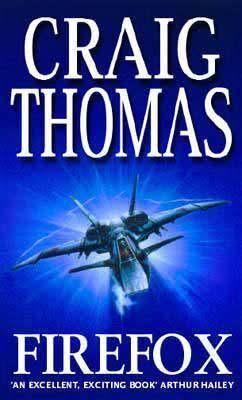7.8 /10 1 Votes7.8
Language English OCLC 2966300 Country United Kingdom | 3.9/5 Goodreads Publication date 8 August 1977 Originally published 8 August 1977 ISBN 0-03-020791-6 | |||||||||||||||||||||||||||||||||
 | ||||||||||||||||||||||||||||||||||
Media type Print (Hardback & Paperback) Pages 288 pp (first edition, hardback) Similar Craig Thomas books, Cold War books | ||||||||||||||||||||||||||||||||||
Firefox is a thriller novel written by Craig Thomas and published in 1977. The Cold War plot involves an attempt by the CIA and MI6 to steal a highly advanced experimental Soviet fighter aircraft. The chief protagonist is fighter pilot turned spy Mitchell Gant. The book was subject to a 1982 film adaptation produced and directed by Clint Eastwood who also played the role of Gant in the film.
Contents
Plot summary
During the cold war, British and American intelligence services learn of the fictional MiG-31 aircraft developed by the USSR during the Cold War. The plane (given the NATO code name "Firefox") embodies a number of technology advances - including stealth technology, hypersonic speeds above Mach 5 and a thought-guided weapons system – dramatically surpassing those of the west.
Faced with an aircraft which will give the Soviet Union the ability to completely dominate the skies, the CIA and MI6 launch a joint mission to steal one of the two Firefox prototype aircraft. Their plan involves using veteran usaf fighter pilot Mitchell Gant, who travels to the Soviet Union under an assumed identity. On paper, Gant is ideally trained to steal Firefox, being fluent in Russian and having already flown captured Soviet planes. Overlooked by his superiors is Gant’s wartime experiences in Vietnam, including his capture by Viet Cong after being shot down, an ordeal exacerbated when the enemy guerrillas are wiped out almost immediately by napalm from an American air strike.
With the help of a network of dissidents and sympathizers, Gant reaches Bilyarsk air base where the two prototype aircraft are being developed. Jewish dissident scientists, forced to work on the project, help Gant penetrate the base, then start a fire to destroy the second prototype and also to distract security troops while Gant steals one of the planes.
Having escaped with the plane, Gant first heads east to the Ural Mountains, then turns south toward Turkey. The Soviets reason that Gant must escape north to the Arctic or south to Turkey, a NATO member. The plane lacks fuel to reach China, and even with stealth capability would never risk the dense Moscow defenses to the west. Gant intentionally encounters an Aeroflot jetliner, then vanishes north, hoping to mislead his pursuers. As a result, the Soviets concentrate their search to the south.
Gant hugs the eastern slopes of the Ural Mountains to evade Soviet acoustical listening stations, but is spotted and fired upon by a SAM station equipped with infrared search sensors. Gant decoys the incoming missiles by destroying a TU-16 Badger that happens upon the scene by chance. Gant escapes, but the Soviets are now alerted to his heading, and redirect their search efforts to the Barents Sea area of the Arctic.
A Soviet warship spots Gant and attacks, firing missiles and attempting to launch a helicopter. Gant decoys the missiles and turbulence from his flyby destroys the helicopter, but he is now nearly out of fuel. With his fuel nearly gone, Gant climbs to stretch out his range. His receiver then detects the homing signal, directing Gant to an ice floe. Landing, Gant finds an American submarine bearing kerosene fuel and using the floe as an ad-hoc runway. The Americans rearm and refuel the Firefox, giving Gant the range to reach his final destination, but barely finish before the arrival of the Soviet warship Gant had earlier encountered. Gant takes off again, narrowly eluding the cruiser's surviving helicopter.
Thinking that he has made good his escape, Gant finds himself under attack by the second Firefox prototype. Realizing that the Soviet scientists failed to destroy the second plane, Gant is forced to dogfight. The second MiG is flown by Tretsov, who is more experienced in the Firefox aircraft and consistently outflies Gant. Nevertheless, after desperate manoeuvrers, Gant realizes that the second plane has been destroyed - during the dogfight he reflexively ordered the thought-controlled weapons system to eject a decoy flare, which was immediately ingested by the second Mig’s jet intake, triggering an internal explosion that destroyed it. Free of pursuit, Gant continues on his journey.
Characters
Origin of the story idea
By the time Thomas began writing Firefox the Soviets had introduced into operational service the MiG-25 Foxbat, the fastest reconnaissance bomber and interceptor in the air, with a top speed of Mach 2.8. Its appearance in the USSR and the Middle East (overflying Israel with impunity) caused a stir in Western aviation and intelligence communities. Thomas' fictional MiG-31 was depicted on the cover of many printings as the Mig-25. At the time of the book's first issue in 1977, stealth technology was a subject of top secret research in defense establishments and had not been operationally deployed (though the Lockheed SR-71 did exhibit stealth-like features). The publisher of the book's first paperback edition, Sphere, gambled that real-life events such as the 1976 defection of the Soviet pilot Viktor Belenko, to risk a 250,000-copy printing. The background material for Firefox was a result of meticulous research, and provided by friends formerly with the RAF, and the Russian setting was derived from guidebooks as he could not afford to visit Moscow.
Adaptations and sequels
Firefox was made into a movie by Warner Brothers based on the novel and released in 1982. Clint Eastwood was the director, producer, and played Mitchell Gant. The novel Firefox Down is a continuation of the story of Firefox, beginning at the moment at which the previous book had concluded.
Many of the characters of Firefox and Firefox Down return for the novel Winter Hawk (1987) and A Different War (1997).
